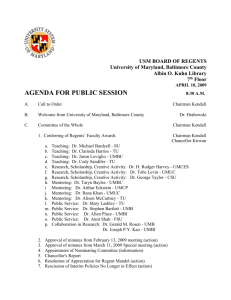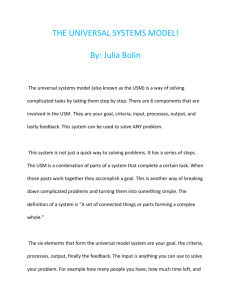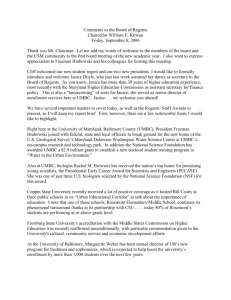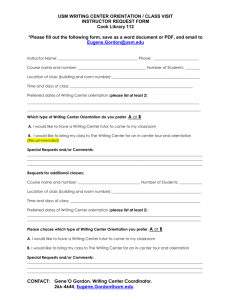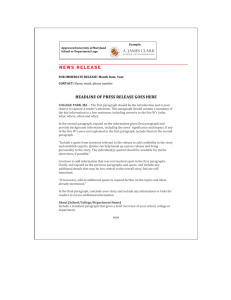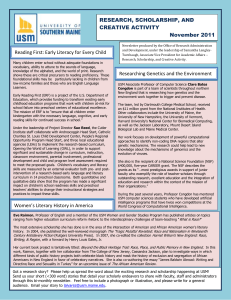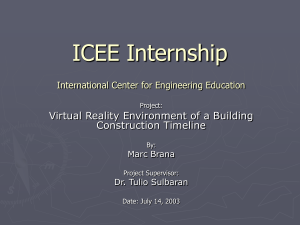Chancellor's Report to the University System of Maryland Board of
advertisement
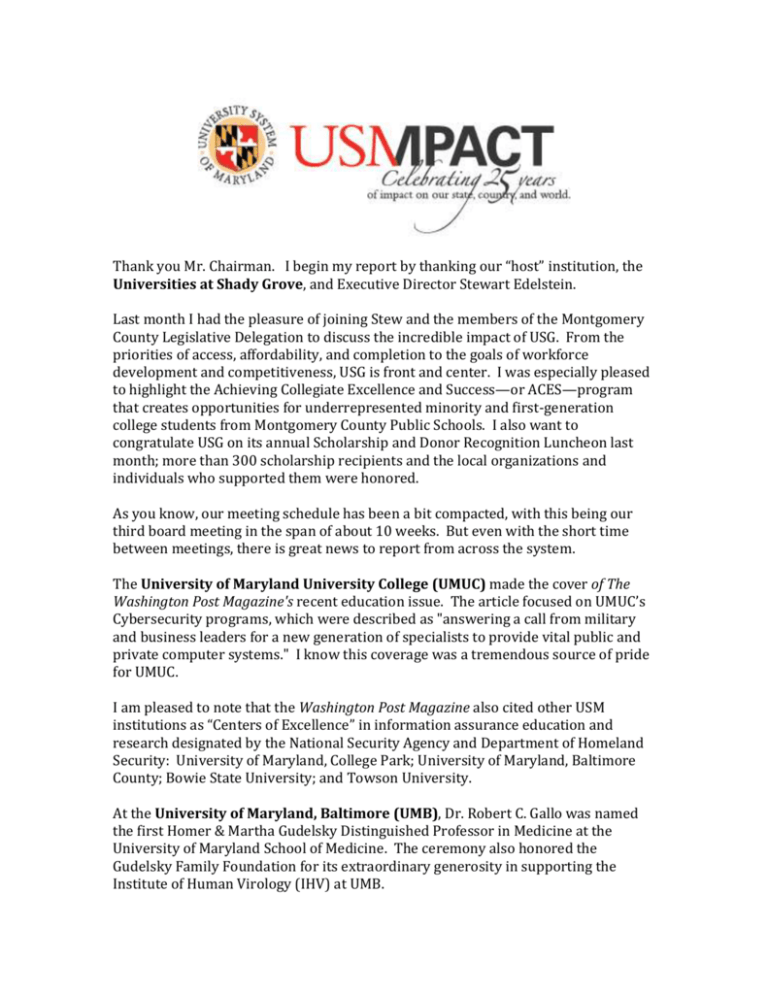
Thank you Mr. Chairman. I begin my report by thanking our “host” institution, the Universities at Shady Grove, and Executive Director Stewart Edelstein. Last month I had the pleasure of joining Stew and the members of the Montgomery County Legislative Delegation to discuss the incredible impact of USG. From the priorities of access, affordability, and completion to the goals of workforce development and competitiveness, USG is front and center. I was especially pleased to highlight the Achieving Collegiate Excellence and Success—or ACES—program that creates opportunities for underrepresented minority and first-generation college students from Montgomery County Public Schools. I also want to congratulate USG on its annual Scholarship and Donor Recognition Luncheon last month; more than 300 scholarship recipients and the local organizations and individuals who supported them were honored. As you know, our meeting schedule has been a bit compacted, with this being our third board meeting in the span of about 10 weeks. But even with the short time between meetings, there is great news to report from across the system. The University of Maryland University College (UMUC) made the cover of The Washington Post Magazine's recent education issue. The article focused on UMUC’s Cybersecurity programs, which were described as "answering a call from military and business leaders for a new generation of specialists to provide vital public and private computer systems." I know this coverage was a tremendous source of pride for UMUC. I am pleased to note that the Washington Post Magazine also cited other USM institutions as “Centers of Excellence” in information assurance education and research designated by the National Security Agency and Department of Homeland Security: University of Maryland, College Park; University of Maryland, Baltimore County; Bowie State University; and Towson University. At the University of Maryland, Baltimore (UMB), Dr. Robert C. Gallo was named the first Homer & Martha Gudelsky Distinguished Professor in Medicine at the University of Maryland School of Medicine. The ceremony also honored the Gudelsky Family Foundation for its extraordinary generosity in supporting the Institute of Human Virology (IHV) at UMB. 2 At the University of Maryland Eastern Shore (UMES), President Juliette B. Bell has assumed the leadership of the Association of Public Land-grant Universities’ (APLU’s) Council of 1890 Universities. Named for the year in which Congress enacted a second Morrill Act establishing Black land-grant universities, The Council of 1890 Universities comprises presidents and chancellors of historically Black landgrant universities and addresses all matters pertaining to strengthening teaching, research, and extension programs at these institutions. At Towson University (TU), Janet Voss Delany, dean of the Office of Graduate Studies, has been named Outstanding Mentor by the American Occupational Therapy Association. In addition, Towson—along with Frostburg State University and Salisbury University—was named by U.S. News & World Report as one of the nation’s Best Colleges for Veterans. The City of Hagerstown has designated the area surrounding the University System of Maryland at Hagerstown (USMH) as the "University District." Lamppost banners that include the USMH logo have been placed for two blocks in two directions. The new designation and signage on the two main thoroughfares in downtown Hagerstown are in response to the center's expansion and its growing importance to Hagerstown and the surrounding region. A new study conducted by scientists at University of Maryland Center for Environmental Science’s (UMCES) Appalachian Laboratory shows that the Clean Air Act has led to improved water quality in the Chesapeake Bay watershed. As UMCES President Don Boesch noted, these improvements in water quality go beyond what was expected when the Clean Air Act was initiated, which shows the power of action taken to promote environmental sustainability. Unfortunately, Don was not able to join us today; he is with Governor Martin O’Malley and other Maryland leaders on a trade mission to Brazil. In other environmental news, students at Bowie State University (BSU) are preparing for green careers thanks to a grant from the National Science Foundation (NSF). Over the next three years, more than 100 undergraduate biology students will participate in cutting-edge research led by BSU faculty; learn the latest laboratory techniques in a new specialized course; and use state-of the-art equipment in campus labs. The grant also lays the foundation for BSU to launch a plant science program combining the expertise of biology and chemistry faculty. At Salisbury University (SU) four computer science majors took first place in the fall 2013 J. P. Morgan “Code for Good” Challenge in New York City. They topped 23 other teams, including ones from Harvard and Carnegie Mellon. More importantly, they used their technical skills to help MANA, a nonprofit that produces and distributes ready-to-use fortified foods to aid malnourished children in developing countries. 3 Coppin State University (CSU) continues to make progress in implementing the recommendations of the Special Review Committee. In fact, last month I joined Mort Neufville and several prominent local business and community leaders to update them on CSU’s progress, solicit their advice and suggestions, and generate a closer relationship between them and CSU going forward. University of Maryland, Baltimore County (UMBC) President Freeman Hrabowski played a major part in Maryland Public Television’s recent special ”Today's Students / Tomorrow's Workforce.” This education special looked at the new Common Core State Standards and how students are being prepared in today’s classrooms for college, career, and the workplace of tomorrow. A link to the video is available on the USM homepage and I encourage you to watch it if you haven’t yet. In addition, last month UMBC launched its first satellite, the Qubscout-S1, which was propelled into a low Earth orbit from a launch site in Russia. The satellite was built as a joint venture between UMBC and Science & Technology Corporation (STC), with UMBC students actively involved. I am pleased to note that the USM’s leadership in the academic transformation arena was on several fronts recently. Frostburg State University (FSU) has created a way for freshmen to do their first semester online through a new initiative called the Freshman Choice Program. With the Freshman Choice Program, all course materials and activities are published and executed online through the use of FSU’s Blackboard course management system. First-year freshmen have access to Computer Science, Pre-Algebra Mathematics, Human Geography, Health in America, Introduction to Sociology, and other courses. With the launch of a spring 2014 online course on the history of the civil rights movement—taught by the Pulitzer Prize-winning author Taylor Branch—the University of Baltimore (UB) will introduce a bold effort to make online learning accessible and intellectually challenging for an expandable universe of students at affordable cost. UB will deliver a pilot course, titled Citizenship and Freedom: The Civil Rights Era, in collaboration with the USM Center for Innovation and Excellence in Learning and Teaching (CIELT). The University of Maryland, College Park (UMCP) is creating a hub for supporting innovative, technology-enhanced education on campus with the launch of the new Teaching and Learning Transformation Center (TLTC). The center was created to help transform the university's courses, teaching, and classrooms through technology and training to improve student learning, engagement, and success. 4 Because of our leadership in academic transformation, I was recently invited to testify before the United States Senate Committee on Health, Education, Labor, and Pensions (HELP). The Committee’s interest in USM’s use of sophisticated technology to simultaneously improve learning outcomes and address the cost of education delivery was evident on both sides of the political aisle. The U.S. Senate HELP Committee also announced the formation of a Task Force on Higher Education Federal Regulations. A group of 14 presidents and chancellors from across the country will examine federal regulations of higher education and make recommendations to streamline and improve these regulations. I will serve as co-chair of this task force along with Chancellor Nick Zeppos from Vanderbilt. This is a wonderful opportunity for higher education to unburden itself of onerous and redundant federal reporting requirements. As another example of USM’s leadership in addressing the critical issues facing higher education, I have been invited to participate in a meeting President Obama is hosting at the White House next week on expanding higher education opportunities for low-income students. Only a select few universities and systems with a demonstrated record of commitment to this goal have been invited to this event. It is certainly a tribute to the Board, USM, the presidents and our institutions that we have been singled out for inclusion in this gathering. Freeman was also invited to attend but can’t do so because of a long-standing commitment. Let me turn to a brief update on the status of FY 2015 Budget development. Over the past few weeks we have had a number of meetings with Governor O’Malley’s staff, Secretary Eloise Foster, and her colleagues at the Department of Budget and Management. The news is disconcerting. It turns out that Sequestration has taken a heavy toll on Maryland’s economy. There is talk of a shortfall of as much as $500 million in projected FY 2015 revenues. As a result, this is clearly shaping up to be a challenging legislative session. The Governor and the General Assembly have treated USM as a top priority in the past and we must redouble our efforts to maintain this status. A strong argument in our favor is the rerun on investment—or ROI—we can point to with last year’s state investment. You will recall that in FY 2014 the Governor and the General Assembly appropriated roughly $30 million for the USM in support of three of the Governor’s and USM’s top priorities: increased STEM enrollment; course redesign; and technology transfer and commercialization to grow Maryland’s innovation economy. As a result of this investment, USM and its institutions were expected to add 1100 additional STEM majors by fall 2016. We actually added 1200 majors this fall. We were supposed to redesign 48 courses by 2017; we are on track to redesign 37 this year alone. We were supposed to increase technology licenses, and companies started based on university-based intellectual property. We’ve already increased licenses by 21 percent and more than doubled the new company formation based on USM created intellectual property. This is quite a record of accomplishment, thanks 5 in large measure to the commitment of our presidents and the superb work of faculty and staff across the USM. Finally, I want to update you on the USM’s 25th anniversary celebration. Since we launched our celebration a few months ago, we have given away some wonderful prizes, including football tickets, symphony tickets, and tickets to other fine arts events. I want to thank the institutions that have donated these prizes in support of our efforts. In addition, we recently posted a wonderful video in which Governor O’Malley congratulates USM on its 25 years of service to the state. Of course, Governor O’Malley’s support has been crucial to our success, so it is especially gratifying to have his participation in this celebration. And I end my report on a few final pieces of great news regarding two of our regents. Last month I had the honor of introducing Norm Augustine as CRDF Global, an independent nonprofit organization that promotes international scientific and technical collaboration, presented him with the George Brown Award for International Scientific Cooperation. Also last month, Regent Tom McMillen had the honor of being inducted into the National Collegiate Basketball Hall of Fame as a member of the class of 2013! Congratulations to both Norm and Tom. This concludes my report. I would be happy to respond to any questions. ###
